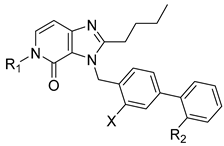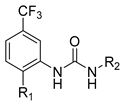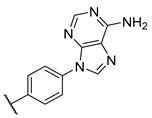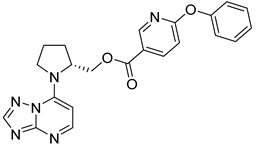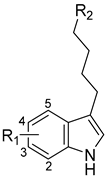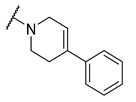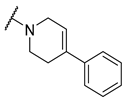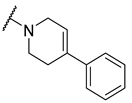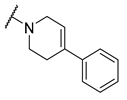Abstract
Open innovation initiatives provide opportunities for collaboration and sharing of knowledge and experience between industry, academia, and government institutions. Through open innovation, Merck is offering a Mini Library of 80 carefully selected compounds from previous research and development projects to a broader scientific community for testing in academic drug discovery projects. These compounds are predominantly drug-like and cover a broad range of molecular targets. They could potentially interact with other enzymes, receptors, transporters, and ion channels of interest. The Mini Library was tested on seven in-house enzymes (bacterial MurA, MurC ligase, and DdlB enzyme, human MAO-A/B, human BChE, and murine AChE), and several hits were identified. A follow-up series of structural analogues provided by Merck gave a more detailed insight into the accessibility and the quality of the hit compounds. For example, sartan derivatives were moderate inhibitors of MurC, whereas bisarylureas were potent, selective, nanomolar inhibitors of hMAO-B. Importantly, 3-n-butyl-substituted indoles were identified as low nanomolar selective inhibitors of hBChE. All in all, the hit derivatives provide new starting points for the further exploration of the chemical space of high-quality enzyme inhibitors.
1. Introduction
Pharmaceutical companies and academic research groups often begin their small molecule drug discovery programs by screening compound libraries against biological targets to identify hit compounds that are, subsequently, optimized for potency, physicochemical, and ADMET properties [1,2,3]. Roughly, more than 16 million compounds are available from commercial vendors [4], and large pharmaceutical companies also have internal screening libraries assembled from several million compounds from previous projects [5]. Despite the development of several alternative approaches to drug design, such as virtual screening [6], the fragment-based hit-to-lead design [7], DNA-encoded libraries [8], and others, high-throughput screening (HTS) remains the most effective method for discovering hits and leads [5]. HTS has served as the starting point for numerous approved drugs [9], such as sitagliptin (DPP IV inhibitor) and rivaroxaban (factor Xa inhibitor). However, two features are critical to the success of a compound library screening: a robust and sensitive biochemical assay against the essential biological target and the quality of the compound library [10]. The most important features that determine the quality of the screening library are size, structural diversity, novelty, purity, and pharmaceutical properties, i.e., lead and/or drug-like properties [5]. In addition, problematic compounds, such as frequent hitters, reactive moieties, or redox-cycling compounds, should be identified and eliminated [10,11].
Drug repurposing is a promising approach to rapidly find new therapeutic options for existing drugs [12]. Hits derived from approved drugs have a significant advantage in the drug optimization process, as a considerable amount of biological data is already available. As part of the open innovation initiative, Merck offers a curated Mini Library of compounds to a broader scientific community that can be tested in biochemical and cell-based assays to identify hits with novel and promising biological activities [13]. Therefore, the Mini Library was assayed against several in-house targets: bacterial MurA, MurC, and DdlB ligases, human butyrylcholinesterase (hBChE), murine acetylcholinesterase (mAChE), and human monoamine oxidases A and B (hMAO-A/B).
Briefly, MurA, MurC, and DdlB ligases are essential bacterial enzymes involved in the cytoplasmic steps of bacterial cell wall biosynthesis [14]. Despite the extensive knowledge of their enzyme kinetics, catalytic mechanisms, and available crystal structures, these enzymes are underutilized as antibacterial targets [15]. On the other hand, BChE, AChE, and MAO-A/B are well-validated targets for neurological disorders, such as Alzheimer’s disease, Parkinson’s disease, and depression, for which several drugs have already been approved [16,17,18,19]. However, recent findings from biological and longitudinal clinical studies are expanding the therapeutic applicability of ligands targeting the above enzymes to other neurodegenerative, cardiac, and malignant diseases [20,21,22,23,24]. The lack of effective ligands against bacterial enzymes and the emerging therapeutic options for the human enzymes described above prompt further drug discovery efforts to find new, well-characterized ligands with desired pharmacological activities.
2. Results and Discussion
Merck’s Mini Library is part of the open innovation initiative, and contains drug-like compounds from former Merck Biopharma research and development projects. Most of these compounds have been well-characterized in vitro and in vivo against their primary targets and toxicologically evaluated to rule out toxic compounds. In addition, clinical data, such as human pharmacokinetics and human safety, are available for certain ligands.
Initially, 80 compounds from Merck’s Mini Library were tested at a concentration of 100 µM against the bacterial enzymes MurA, MurC, and DdlB, and at a concentration of 10 µM against the remaining enzymes, i.e., hBChE, mAChE, hMAO-A, and hMAO-B (Supporting Information, Table S1). Results were expressed as residual activities (RAs) at the indicated compound concentration. Three compounds showed a moderate inhibition of MurA, three sartan derivatives inhibited MurC, four compounds were active against hBChE, three against mAChE, and only two inhibited hMAO-B. No active compounds were found against DdlB and hMAO-A. To determine the IC50 values and to explore the chemical space around the active ligands, Merck secured sufficient amounts of active compounds and their structural analogues.
Salicylic acid analogues have been described as potent and selective inhibitors of glomerular epithelial protein-1 [25], which plays an important role in controlling the chemotaxis of various types of leukocytes. In our screening campaign, they were identified as inhibitors of the bacterial enzymes MurA, mAChE, and hBChE (Figure 1, Table 1, and Table S2). In general, the compounds inhibited mAChE in the nanomolar range, and MurA was inhibited with IC50 values in the low micromolar range. The substitution of the hydroxyl group with fluorine did not affect the inhibitory potency on both MurA and mAChE (MS-ML24 vs. MS-ML26). The introduction of an amide bond also did not alter the inhibitory potencies to a significant extent (MS-ML24 vs. MS-ML25). The preferred substitution at the diphenylacetylene moiety was a linear alkyl chain, i.e., n-butyl, while the alkyl substituent at the amine/amide did not affect the observed activities. Unfortunately, these compounds did not show clear structure–activity relationships (SARs) against any of the targets, which was also reflected in higher Hill coefficients (>1.5), which could also indicate a nonspecific inhibition due to the highly lipophilic chemical structure, leading to poor solubility in the micromolar concentration range [26]. In addition, the presence of negatively charged moieties—i.e., carboxylic acids—is not optimal for permeation through the blood–brain barrier, which is a prerequisite for target enzymes located in the central nervous system (i.e., AChE and BChE), making salicylic acid analogues of no major interest for further development as cholinesterase inhibitors [27].

Figure 1.
Structures and in vitro inhibitory potencies of hits from class of salicylic acid analogues.

Table 1.
In vitro inhibitory potencies of salicylic acid analogues against MurA, mAChE, and hBChE.
4,5-Dihydro-4-oxo-3H-imidazo[4,5-c]pyridine derivatives are nonpeptide angiotensin II receptor antagonists. This class of compounds, named sartans, is widely used in clinics for the treatment of hypertension and heart failure [28,29,30]. The follow-up sartan derivatives were assayed at 100 µM against MurC, and the IC50 values were determined for compounds showing RAs below 50% (Table 2). Most sartan analogues inhibited MurC in a micromolar concentration range, with IC50 values of approximately 100 µM. Variously substituted benzyls were well-tolerated at position five of the 3,5-dihydro-4H-imidazo[4,5-c]pyridin-4-one core, whereas the introduction of the acyclic tert-butyl moiety was not tolerated and resulted in the loss of MurC inhibition (compounds 15 and 17). To further explore the SARs of the sartan analogues against MurC, a larger number of compounds would need to be tested.

Table 2.
In vitro inhibitory potencies of sartan derivatives against MurC.
The Mini Library screening identified two structurally distinct classes of hMAO-B inhibitors (Table 3 and Table S3). Heterocyclic-substituted bisarylureas were patented by Merck as kinase inhibitors; notably, these compounds inhibit the VEGF-stimulated mitogenesis of human vascular endothelial cells [31]. In addition, triazaindolizines have been patented as inhibitors of methionine aminopeptidase 2 [32]. Several bisarylureas inhibited hMAO-B in the low micromolar to submicromolar range, and small structural changes resulted in large differences in inhibitory potencies. For example, the introduction of N-methylacetamide on the pyridine ring resulted in the complete loss of activity, whereas the replacement of the pyridine moiety with aminopurine (22) or the complete removal of the pyridine to obtain p-aniline analogue 23 resulted in equipotent inhibitors. The introduction of substituents on the pyridine ring, e.g., N,N-dimethylethyl (27) or piperidine-1-ethyl (28), resulted in active compounds. Only triazaindolizine MS-ML31 with the phenyloxypyridinyl fragment inhibited hMAO-B (Table 3). The replacement of phenyloxypyridine with substituted quinolines, (tetrahydro)isoquinolines, and phenyls completely abolished hMAO-B inhibition (Table S3). All compounds were inactive against hMAO-A, indicating that bisarylureas were selective hMAO-B inhibitors.

Table 3.
In vitro inhibitory potencies of bisarylureas against hMAO-A and hMAO-B, and representative triazaindolizine inhibitor of hMAO-B.
A number of indoles were described by Merck as dopaminergic receptor agonists [33], and these compounds were found to be potent hBChE inhibitors (Table 4). The most potent inhibitors were analogues with unsubstituted or substituted indoles via an n-butyl linker to 4-phenyl-1,2,3,6-tetrahydropyridine. Bulky groups such as naphthene (30) or 6-methoxy-2-methyl-2,3,4,9-tetrahydro-1H-pyrido[3,4-b]indole (37) linked to 1,2,3,6-tetrahydropyridine reduced hBChE inhibition. All compounds were also assayed for their mAChE inhibition, and most of them were selective hBChE inhibitors. Indole and tryptophan derivatives are known hBChE inhibitors and have also been extensively studied in our group as promising pharmacological tool molecules and lead compounds for the treatment of Alzheimer’s disease [34,35].

Table 4.
In vitro inhibitory potencies of indoles against hBChE and mAChE.
3. Materials and Methods
Inhibitory activities were expressed as residual activities (RAs) in percent. IC50 values were determined for the most potent inhibitors and were given as IC50 ± SEM. Compounds were provided by Merck as 10 mM stock solutions in DMSO.
3.1. Inhibition of Mur Enzymes and DdlB
Inhibition of Mur enzymes was monitored with the colorimetric malachite green method, which measured orthophosphate formed during reaction [36]. The mixtures with a final volume of 50 µL contained:
MurA: 50 mM HEPES-NaOH, pH 7.8, 0.005% Triton X-114, 200 µM uridine-diphosphate-N-acetylglucosamine, 100 µM phosphoenolpyruvate, purified MurA, and 50 or 100 µM of each compound tested.
MurC: 50 mM HEPES-NaOH, pH 8.0, 5 mM MgCl2, 0.005% Triton X-114, 120 µM L-Ala, 120 µM UDP-N-acetyl-muramic acid, 450 µM ATP, purified MurC, and 50 or 100 µM of each compound tested.
DdlB: 50 mM HEPES-NaOH, pH 8.0, 5 mM MgCl2, 6.5 mM (NH4)2SO4, 10 mM KCl, 0.005% Triton X-114, 700 µM D-Ala, 500 µM ATP, purified DdlB, and 50 µM of each compound tested.
All compounds were soluble in the assay mixtures containing 5% DMSO (v/v). After incubation for 15 min (20 min for DdlB) at 37 °C, the enzyme reaction was terminated by addition of Biomol® reagent (100 µL) and absorbance was measured after 5 min at 650 nm (Synergy™ H4 microplate reader; BioTek Instruments, Inc., BioTek Gen5 Data Analysis Software, version 2.9, Santa Clara, CA, USA). All experiments were performed in duplicate. Residual activities (RAs) were calculated in comparison to assays, where 5% DMSO replaced the compound, and IC50 values were determined by measuring the RAs at seven different compound concentrations.
3.2. Inhibition of hBChE and mAChE
Enzyme solutions were prepared by diluting the concentrated enzyme stock solutions (4.6 mg/mL in 10 mM MES-NaOH buffer, pH 6.5) in a sodium phosphate-buffered solution (0.1 M, pH 8.0). Reactions were performed in 0.1 M phosphate-buffered solution, pH 8.0, containing 370 μM 5,5′-dithiobis(2-nitrobenzoic acid) (DTNB), 500 μM substrate (butyrylthiocholine and acetylthiocholine for hBChE and mAChE, respectively), and 1 nM hBChE or 50 pM mAChE. The final organic solvent (DMSO) content was always 1% (v/v). Reactions were initiated by adding the substrate to the enzyme and inhibitor, which were preincubated for 5 min. The increase in absorbance at 412 nm was monitored for 2 min using a microplate reader (Synergy™ H4 microplate reader; BioTek Instruments, Inc., BioTek Gen5 Data Analysis Software, version 2.9, Santa Clara, CA, USA). To determine the blank value (b), the enzyme solution was replaced by a phosphate-buffered solution. The initial velocity (v) was calculated from the slope of the linear trend obtained, with each measurement performed in triplicate. The inhibitory potencies were expressed as where vi is the velocity in the presence of the test compounds and vo is the control velocity in the presence of DMSO. Seven different concentrations of each compound were used for the IC50 measurements. IC50 values were obtained by plotting the residual enzyme activities against the applied inhibitor concentrations, fitting the experimental data to the 4-parameter Hill equation:
where X is the logarithm of the inhibitor concentration, and Y is the residual activity. GraphPad Prism 8.2.0 (GraphPad Software, San Diego, CA, USA) was used for the fitting procedure.
3.3. Inhibition of hMAO-A and hMAO-B
The effects of the compounds on hMAO-A and hMAO-B were investigated using a fluorimetric assay, following a method previously described in the literature [37]. Recombinant human microsomal hMAO enzymes expressed in BTI-TN-5B1-4 baculovirus-infected insect cells, horseradish peroxidase (HRP, type II, lyophilized powder), and p-tyramine hydrochloride were purchased from Sigma Aldrich. 10-Acetyl-3,7-dihydroxyphenoxazine (Amplex Red reagent) was synthesized as described in the literature [38].
Briefly, 100 µL of 50 mM sodium phosphate buffer (pH 7.4, 0.05% (v/v) Triton X-114), containing the compounds and hMAO-A or hMAO-B, was incubated for 15 min at 37 °C in a flat-bottomed black 96-well microplate protected from ambient light. After preincubation, the reaction was started by adding final concentrations of 200 µM Amplex Red reagent, 2 U/mL HRP, and 1 mM p-tyramine hydrochloride. Resorufin production was quantified based on the fluorescence produced (λex = 530 nm; λem = 590 nm) at 37 °C over a 20 min period. For the control experiments, DMSO was used instead of appropriate dilutions of the compounds in DMSO. For the determination of blank (b), the enzyme solution was replaced by a phosphate-buffered solution. Initial velocities were calculated from the obtained trend, with each measurement performed in duplicate. Specific fluorescence emission to determine the final results was calculated after subtracting the blank activity (b). Inhibitory potencies were expressed as RAs, and IC50 values were calculated as described in the section “Inhibition of hBChE and mAChE” above.
4. Conclusions
Overall, compound library screening is a viable route to obtaining novel ligands targeting underexploited proteins in the field of antibacterial agents or fully validated enzymes that form the core of Alzheimer’s and Parkinson’s disease therapy. We performed a successful screening of Merck’s Mini Library on seven in-house enzymes, revealing several hit compounds. Particular attention should be paid to validate the activity detected in the screening phase and not to pursue hits with questionable activity. Salicylic acid analogues fell into the latter category, while sartans, as moderate MurC inhibitors, needed to be validated in secondary assays to confirm the clear SARs of these hits. On the other hand, bisarylureas and indoles as selective, nanomolar hMAO-B and hBChE inhibitors, respectively, in combination with Merck’s data on these derivatives (e.g., selectivity, preclinical pharmacokinetics, and toxicology) [39,40,41,42,43,44,45,46,47,48,49], provided a solid foundation for the further exploration of their activities. Further cell-based and in vivo rodent models of neurodegenerative diseases should be used to reveal the true potential of hit compounds as potential agents against neurodegenerative disorders.
Supplementary Materials
The following supporting information can be downloaded at: https://www.mdpi.com/article/10.3390/molecules27144484/s1, Table S1: In vitro inhibitory potencies of Merck’s Mini Library against MurA, MurC, DdlB, mAChE, hBChE, hMAO-A/B; Table S2: Structures of salicylic acid derivatives; Table S3: In vitro inhibitory potencies of triazaindolizines derivatives against hMAO-B and hMAO-A.
Author Contributions
Conceptualization, M.H., D.K. and S.G.; methodology, M.H. and D.K.; validation, M.H. and D.K.; formal analysis, M.H. and D.K.; investigation, M.H. and D.K.; resources, S.G., D.K. and M.H.; writing—original draft preparation, M.H. and D.K.; writing—review and editing, M.H., D.K. and S.G.; visualization, M.H. and D.K.; project administration, M.H., D.K. and S.G.; funding acquisition, S.G. and D.K. All authors have read and agreed to the published version of the manuscript.
Funding
This research was funded by the Slovenian Research Agency (core research funding P1-0208, and projects Z1-1859 and J1-2484).
Data Availability Statement
The data that support the findings of this study are available from the corresponding author, M.H., upon reasonable request.
Acknowledgments
We thank Merck for supplying the Biopharma Mini Library.
Conflicts of Interest
The authors declare no conflict of interest.
Sample Availability
Samples of the compounds are available from Merck upon request (https://www.merckgroup.com/en/research/open-innovation/biopharma-open-innovation-portal/biopharma-mini-library.html, accessed on 15 May 2022).
References
- Macarron, R. Critical Review of the Role of HTS in Drug Discovery. Drug Discov. Today 2006, 11, 277–279. [Google Scholar] [CrossRef] [PubMed]
- Macarron, R.; Banks, M.N.; Bojanic, D.; Burns, D.J.; Cirovic, D.A.; Garyantes, T.; Green, D.V.S.; Hertzberg, R.P.; Janzen, W.P.; Paslay, J.W.; et al. Impact of High-Throughput Screening in Biomedical Research. Nat. Rev. Drug Discov. 2011, 10, 188–195. [Google Scholar] [CrossRef] [PubMed]
- Karawajczyk, A.; Giordanetto, F.; Benningshof, J.; Hamza, D.; Kalliokoski, T.; Pouwer, K.; Morgentin, R.; Nelson, A.; Müller, G.; Piechot, A.; et al. Expansion of Chemical Space for Collaborative Lead Generation and Drug Discovery: The European Lead Factory Perspective. Drug Discov. Today 2015, 20, 1310–1316. [Google Scholar] [CrossRef] [PubMed] [Green Version]
- Volochnyuk, D.M.; Ryabukhin, S.V.; Moroz, Y.S.; Savych, O.; Chuprina, A.; Horvath, D.; Zabolotna, Y.; Varnek, A.; Judd, D.B. Evolution of Commercially Available Compounds for HTS. Drug Discov. Today 2019, 24, 390–402. [Google Scholar] [CrossRef]
- Follmann, M.; Briem, H.; Steinmeyer, A.; Hillisch, A.; Schmitt, M.H.; Haning, H.; Meier, H. An Approach towards Enhancement of a Screening Library: The Next Generation Library Initiative (NGLI) at Bayer—Against All Odds? Drug Discov. Today 2019, 24, 668–672. [Google Scholar] [CrossRef]
- da Silva Rocha, S.F.L.; Olanda, C.G.; Fokoue, H.H.; Sant’Anna, C.M.R. Virtual Screening Techniques in Drug Discovery: Review and Recent Applications. Curr. Top. Med. Chem. 2019, 19, 1751–1767. [Google Scholar] [CrossRef]
- Li, Q. Application of Fragment-Based Drug Discovery to Versatile Targets. Front. Mol. Biosci. 2020, 7, 180. [Google Scholar] [CrossRef]
- Goodnow, R.A.; Dumelin, C.E.; Keefe, A.D. DNA-Encoded Chemistry: Enabling the Deeper Sampling of Chemical Space. Nat. Rev. Drug Discov. 2017, 16, 131–147. [Google Scholar] [CrossRef]
- Brown, D.G.; Boström, J. Where Do Recent Small Molecule Clinical Development Candidates Come From? J. Med. Chem. 2018, 61, 9442–9468. [Google Scholar] [CrossRef]
- Boss, C.; Hazemann, J.; Kimmerlin, T.; Von Korff, M.; Lüthi, U.; Peter, O.; Sander, T.; Siegrist, R. The Screening Compound Collection: A Key Asset for Drug Discovery. CHIMIA 2017, 71, 667. [Google Scholar] [CrossRef]
- Proj, M.; Knez, D.; Sosič, I.; Gobec, S. Redox Active or Thiol Reactive? Optimization of Rapid Screens to Identify Less Evident Nuisance Compounds. Drug Discov. Today 2022, 27, 1733–1742. [Google Scholar] [CrossRef] [PubMed]
- Pushpakom, S.; Iorio, F.; Eyers, P.A.; Escott, K.J.; Hopper, S.; Wells, A.; Doig, A.; Guilliams, T.; Latimer, J.; McNamee, C.; et al. Drug Repurposing: Progress, Challenges and Recommendations. Nat. Rev. Drug Discov. 2019, 18, 41–58. [Google Scholar] [CrossRef] [PubMed]
- Biopharma Mini Library—Research. Available online: https://www.merckgroup.com/en/research/open-innovation/biopharma-open-innovation-portal/biopharma-mini-library.html (accessed on 19 April 2022).
- Barreteau, H.; Kovač, A.; Boniface, A.; Sova, M.; Gobec, S.; Blanot, D. Cytoplasmic Steps of Peptidoglycan Biosynthesis. FEMS Microbiol. Rev. 2008, 32, 168–207. [Google Scholar] [CrossRef] [PubMed] [Green Version]
- Hrast, M.; Sosič, I.; Šink, R.; Gobec, S. Inhibitors of the Peptidoglycan Biosynthesis Enzymes MurA-F. Bioorganic Chem. 2014, 55, 2–15. [Google Scholar] [CrossRef] [PubMed]
- Hampel, H.; Mesulam, M.-M.; Cuello, A.C.; Farlow, M.R.; Giacobini, E.; Grossberg, G.T.; Khachaturian, A.S.; Vergallo, A.; Cavedo, E.; Snyder, P.J.; et al. The Cholinergic System in the Pathophysiology and Treatment of Alzheimer’s Disease. Brain 2018, 141, 1917–1933. [Google Scholar] [CrossRef]
- Haake, A.; Nguyen, K.; Friedman, L.; Chakkamparambil, B.; Grossberg, G.T. An Update on the Utility and Safety of Cholinesterase Inhibitors for the Treatment of Alzheimer’s Disease. Expert Opin. Drug Saf. 2020, 19, 147–157. [Google Scholar] [CrossRef]
- Youdim, M.B.H. Monoamine Oxidase Inhibitors, and Iron Chelators in Depressive Illness and Neurodegenerative Diseases. J. Neural Transm. 2018, 125, 1719–1733. [Google Scholar] [CrossRef]
- Riederer, P.; Müller, T. Monoamine Oxidase-B Inhibitors in the Treatment of Parkinson’s Disease: Clinical–Pharmacological Aspects. J. Neural Transm. 2018, 125, 1751–1757. [Google Scholar] [CrossRef]
- Mialet-Perez, J.; Parini, A. Cardiac Monoamine Oxidases: At the Heart of Mitochondrial Dysfunction. Cell Death Dis. 2020, 11, 54 . [Google Scholar] [CrossRef]
- Iacovino, L.G.; Manzella, N.; Resta, J.; Vanoni, M.A.; Rotilio, L.; Pisani, L.; Edmondson, D.E.; Parini, A.; Mattevi, A.; Mialet-Perez, J.; et al. Rational Redesign of Monoamine Oxidase A into a Dehydrogenase to Probe ROS in Cardiac Aging. ACS Chem. Biol. 2020, 15, 1795–1800. [Google Scholar] [CrossRef]
- Park, J.-H.; Ju, Y.H.; Choi, J.W.; Song, H.J.; Jang, B.K.; Woo, J.; Chun, H.; Kim, H.J.; Shin, S.J.; Yarishkin, O.; et al. Newly Developed Reversible MAO-B Inhibitor Circumvents the Shortcomings of Irreversible Inhibitors in Alzheimer’s Disease. Sci. Adv. 2019, 5, eaav0316. [Google Scholar] [CrossRef] [PubMed] [Green Version]
- Wang, X.; Li, B.; Kim, Y.J.; Wang, Y.-C.; Li, Z.; Yu, J.; Zeng, S.; Ma, X.; Choi, I.Y.; Di Biase, S.; et al. Targeting Monoamine Oxidase A for T Cell–Based Cancer Immunotherapy. Sci. Immunol. 2021, 6, eabh2383. [Google Scholar] [CrossRef] [PubMed]
- Gross, M.E.; Agus, D.B.; Dorff, T.B.; Pinski, J.K.; Quinn, D.I.; Castellanos, O.; Gilmore, P.; Shih, J.C. Phase 2 Trial of Monoamine Oxidase Inhibitor Phenelzine in Biochemical Recurrent Prostate Cancer. Prostate Cancer Prostatic Dis. 2021, 24, 61–68. [Google Scholar] [CrossRef] [PubMed]
- Gobert, R.P.; van den Eijnden, M.; Szyndralewiez, C.; Jorand-Lebrun, C.; Swinnen, D.; Chen, L.; Gillieron, C.; Pixley, F.; Juillard, P.; Gerber, P.; et al. GLEPP1/Protein-Tyrosine Phosphatase φ Inhibitors Block Chemotaxis in Vitro and in Vivo and Improve Murine Ulcerative Colitis. J. Biol. Chem. 2009, 284, 11385–11395. [Google Scholar] [CrossRef] [Green Version]
- Copeland, R.A. Evaluation of Enzyme Inhibitors in Drug Discovery: A Guide for Medicinal Chemists and Pharmacologists, 2nd ed.; Wiley, John Wiley & Sons: Hoboken, NJ, USA, 2013. [Google Scholar]
- Seelig, A. The Role of Size and Charge for Blood–Brain Barrier Permeation of Drugs and Fatty Acids. J. Mol. Neurosci. 2007, 33, 32–41. [Google Scholar] [CrossRef] [Green Version]
- Mederski, W.W.; Dorsch, D.; Bokel, H.H.; Beier, N.; Lues, I.; Schelling, P. Non-peptide angiotensin II receptor antagonists: Synthesis and biological activity of a series of novel 4,5-dihydro-4-oxo-3H-imidazo[4,5-c]pyridine derivatives. J. Med. Chem. 1994, 27, 1632–1645. [Google Scholar] [CrossRef]
- Mederski, W.W.; Dorsch, D.; Osswald, M.; Beier, N.; Lues, I.; Minck, K.-O.; Schelling, P.; Ladstetter, B.J. 4,5-Dihydro-4-oxo-3H-imidazo[4,5-c]pyridines: Potent arylacetic acid-derived AT1 antagonists with improved affinity for the AT2 receptor. Bioorg. Med. Chem. Lett. 1995, 5, 2665–2670. [Google Scholar] [CrossRef]
- Mederski, W.W.; Dorsch, D.; Osswald, M.; Schwartz, H.; Beier, N.; Christadler, M.; Minck, K.O.; Schelling, P.; Schmitges, C.J. Novel 4,5-dihydro-4-oxo-3H-imidazo[4,5-c]pyridines. Potent angiotensin II receptor antagonists with high affinity for both the AT1 and AT2 subtypes. Eur. J. Med. Chem. 1997, 32, 479–491. [Google Scholar] [CrossRef]
- Stieber, F.; Jonczyk, A.; Hoelzemann, G.; Buchstaller, H.-P.; Burgdorf, L.T.; Rautenberg, W.; Greiner, H. Heterocyclic Substituted Bisarylurea Derivates as Kinase Inhibitors. WO2006040056A1, 20 April 2006. [Google Scholar]
- Heinrich, T.; Zenke, F.; Krier, M.; Schiemann, K. Novel Heterocyclic Compounds for Use as Metap-2 Inhibitors. WO2010083870, 29 July 2010. [Google Scholar]
- Boettcher, H.; Barnickel, G.; Hausberg, H.H.; Haase, A.F.; Seyfried, C.A.; Eiermann, V. Synthesis and Dopaminergic Activity of Some 3-(1,2,3,6-Tetrahydro-1-Pyridylalkyl)Indoles. A Novel Conformational Model to Explain Structure-Activity Relationships. J. Med. Chem. 1992, 35, 4020–4026. [Google Scholar] [CrossRef]
- Meden, A.; Knez, D.; Malikowska-Racia, N.; Brazzolotto, X.; Nachon, F.; Svete, J.; Sałat, K.; Grošelj, U.; Gobec, S. Structure-Activity Relationship Study of Tryptophan-Based Butyrylcholinesterase Inhibitors. Eur. J. Med. Chem. 2020, 208, 112766. [Google Scholar] [CrossRef]
- Meden, A.; Knez, D.; Brazzolotto, X.; Nachon, F.; Dias, J.; Svete, J.; Stojan, J.; Grošelj, U.; Gobec, S. From Tryptophan-Based Amides to Tertiary Amines: Optimization of a Butyrylcholinesterase Inhibitor Series. Eur. J. Med. Chem. 2022, 234, 114248. [Google Scholar] [CrossRef]
- Lanzetta, P.A.; Alvarez, L.J.; Reinach, P.S.; Candia, O.A. An Improved Assay for Nanomole Amounts of Inorganic Phosphate. Anal. Biochem. 1979, 100, 95–97. [Google Scholar] [CrossRef]
- Zhou, M.; Diwu, Z.; Panchuk-Voloshina, N.; Haugland, R.P. A Stable Nonfluorescent Derivative of Resorufin for the Fluorometric Determination of Trace Hydrogen Peroxide: Applications in Detecting the Activity of Phagocyte NADPH Oxidase and Other Oxidases. Anal. Biochem. 1997, 253, 162–168. [Google Scholar] [CrossRef] [PubMed]
- Von der Eltz, H.; Guder, H.J.; Muhlegger, K. New Hydrolase Substrates. U.S. Patent 4900822A, 13 February 1990. [Google Scholar]
- Seyfried, C.A.; Greiner, H.E.; Haase, A.F. Biochemical and functional studies on EMD 49,980: A potent, selectively presynaptic D-2 dopamine agonist with actions on serotonin systems. Eur. J. Pharmacol. 1989, 24, 31–41. [Google Scholar] [CrossRef]
- Klimke, A.; Klieser, E. Antipsychotic efficacy of the dopaminergic autoreceptor agonist EMD 49980 (Roxindol). Results of an open clinical study. Pharmacopsychiatry 1991, 24, 107–112. [Google Scholar] [CrossRef]
- Kasper, S.; Fuger, J.; Zinner, H.J.; Bäuml, J.; Möller, H.J. Early clinical results with the neuroleptic roxindole (EMD 49,980) in the treatment of schizophrenia-an open study. Eur. Neuropsychopharmacol. 1992, 2, 91–95. [Google Scholar] [CrossRef]
- Gründer, G.; Wetzel, H.; Hammes, E.; Benkert, O. Roxindole, a dopamine autoreceptor agonist, in the treatment of major depression. Psychopharmacology 1993, 111, 123–126. [Google Scholar] [CrossRef]
- Bravi, D.; Davis, T.L.; Mouradian, M.M.; Chase, T.N. Treatment of Parkinson's disease with the partial dopamine agonist EMD 49980. Mov. Disord. 1993, 8, 195–197. [Google Scholar] [CrossRef]
- Seyfried, C.A.; Adam, G. Studies on the interaction of roxindole with brain monoamine oxidases and dopaminergic neurones in vitro and in vivo. Pharmacol. Toxicol. 1994, 74, 314–320. [Google Scholar] [CrossRef]
- Seyfried, C.A.; Bartoszyk, G.D. Sensitivity of dopamine D2 receptors following long-term treatment with roxindole. Eur. J. Pharmacol. 1994, 12, 67–72. [Google Scholar] [CrossRef]
- Wiedemann, K.; Kellner, M. Endocrine characterization of the new dopamine autoreceptor agonist roxindole. Exp. Clin. Endocrinol. 1994, 102, 284–288. [Google Scholar] [CrossRef] [PubMed]
- Bartoszyk, G.D.; Harting, J.; Minck, K.O. Roxindole: Psychopharmacological profile of a dopamine D2 autoreceptor agonist. J. Pharmacol. Exp. Ther. 1996, 276, 41–48. [Google Scholar] [PubMed]
- Kleven, M.S.; Koek, W. Differential effects of direct and indirect dopamine agonists on eye blink rate in cynomolgus monkeys. J. Pharmacol. Exp. Ther. 1996, 279, 1211–1219. [Google Scholar] [PubMed]
- Bartoszyk, G.D. Anxiolytic effects of dopamine receptor ligands: I. Involvement of dopamine autoreceptors. Life Sci. 1998, 62, 649–663. [Google Scholar] [CrossRef]
Publisher’s Note: MDPI stays neutral with regard to jurisdictional claims in published maps and institutional affiliations. |
© 2022 by the authors. Licensee MDPI, Basel, Switzerland. This article is an open access article distributed under the terms and conditions of the Creative Commons Attribution (CC BY) license (https://creativecommons.org/licenses/by/4.0/).
